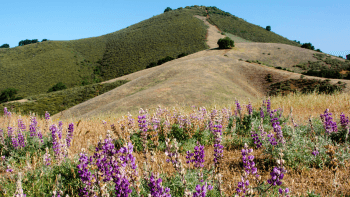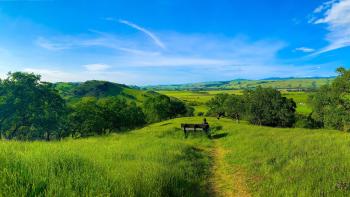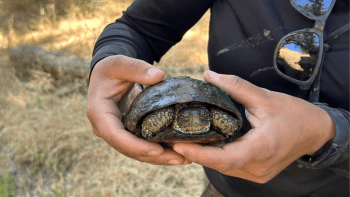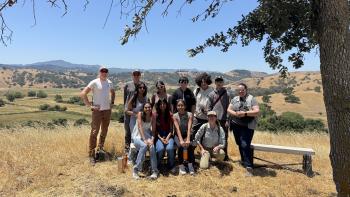Volunteer Restoration - A Year at Furtado
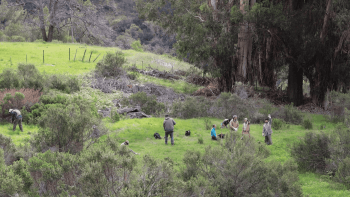
For years, delicate riparian habitat at Furtado Barn became overtaken by invasive white horehound, mustard, thistles, and poison hemlock, making it difficult for native plants to survive. Starting in 2017, Open Space Authority field staff and volunteers gradually started pulling weeds as time allowed to help the native species grow. But in 2020, staff officially launched the Furtado Barn Restoration Area with field staff and volunteers providing a dedicated effort to address invasive plants and restore the natural ecosystem.
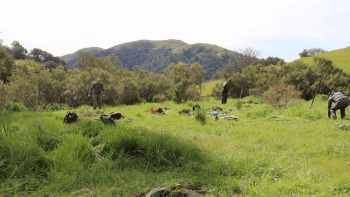
Stewardship events like monthly Land Stewards efforts have a long history at the Open Space Authority. Over the last few years, the program provides an increasingly integral role in ongoing restoration and land management work. Volunteers dedicate hundreds of hours restoring the land, removing trash and invasives from the preserves, and managing landscapes and trails so the public can enjoy them. But what do these restoration efforts look like?
According to Kat Hill, Volunteer Program Coordinator at the Authority, the Open Space Authority has two main goals when it comes to the restoration and management of our landscapes. The first is removal of invasive monocultures, where possible, and the second is replacement with native biodiversity. In the cases where invasives cannot be eliminated, managing their growth and spread is the next best thing.
Eliminate
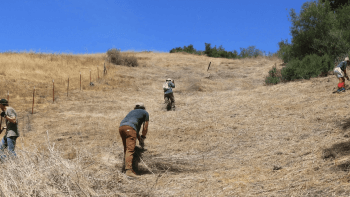
The Open Space Authority is also piloting a new eradication process. Last August, the Authority conducted its first “solarization” to heat the soil to a temperature high enough to kill the seed bed at Furtado Barn. To begin, in late summer, volunteers dampen the soil until it is at about 50-70% moisture, and then lay clear sheets of plastic over the plot and anchor it down so the wind does not catch it. They leave this for at least two weeks, and regularly measure the temperature of the soil, looking for a consistent temperature of 110-115°F or higher over the two-week period. Steam builds up beneath the plastic, ideally killing any seeds underneath.
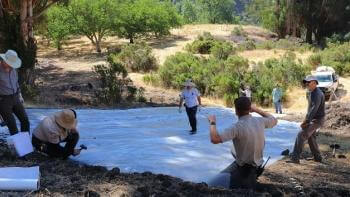
This project was largely successful – in the areas at the top of the hill most exposed to the sun, less than 10% of weeds came back compared to outside the solarized area, except for the seeds they planted afterwards. For this process, however, there are tradeoffs. “This isn’t the type of approach that we want to do a lot,” Hill mentions. “We want to minimize the amount of plastic waste we produce, and this isn’t something we can do in many areas – it will kill any seeds underneath the plastic, invasive and native alike, so this is best in places where invasives have completely overrun and places we want to ‘start over,’ so to speak.”
After the initial elimination approach, it’s time to plant! Staff gathered seeds or purchased them from ethically sourced seed companies, then brought them out for the volunteers to plant. The strategy was to plant them in recognizable rows that don’t make them look “planted,” but to allow staff and volunteers to discern what they’ve planted versus what potential invasives are sprouting up, thus determining the effectiveness of the planting. Afterwards, they reflect – “how successful was that planting? What do we change, and what do we repeat?”
Maintain
Now volunteers and field staff go out to Furtado every month to weed around the native plants and give them as much opportunity to grow as possible. “The best way to do this is to remove the weeds before they seed,” Hill notes. “We want to force the population to more manageable levels and prevent competition for space and light.”
This year, the Xerces Society donated 1,440 native plant kits to the Authority for the enhancement of the Furtado restoration area. In November, volunteers will install the plant plugs -- including coyote brush, a variety of milkweeds, hollyleaf cherry, western goldenrod, and many more -- and disperse native grass seeds. Transplanting seedlings can be stressful for plants, so field staff will install irrigation around the barn to support the plant plugs with a consistent water supply in their first year.
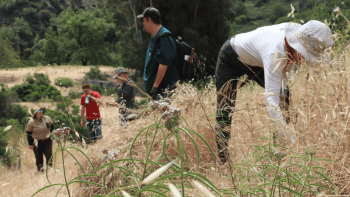
“The Authority strives to be nimble and innovative and is thus always seeking ways to maximize the results of our efforts, and to perform the highest-quality work in the most efficient way possible,” Hill says. “And as the Authority's Natural Resources efforts expand, seeking sustainable solutions is a priority.” Trying methods like solarization are great labor-saving techniques and, ideally, as native plants get established, they can better fend for themselves.
Process & Refine
And how does the agency prioritize which areas to restore? Well, like restoration itself, it’s iterative. One factor to consider is the potential an area has for restoration. In the case of Furtado, the areas that aren’t disturbed are rich with native plants like blue elderberry, milkweed, sage brush, and monkey flower, among other iconic native plants and plant communities, so these plant communities have the potential to thrive at a much larger scale in the area.
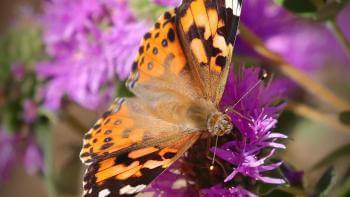
Another factor to consider is how restoration can serve or benefit the larger ecosystem. The area around the Furtado Barn supports a variety of native animal species, including the grey fox, burrowing owls, red-tailed hawks, monarch butterflies, and many more. Encouraging the growth of native plants means encouraging the food supply of the animals that depend on them.
Foster Community
“Working together at the Furtado Barn has fostered a lot of community and care for this one particular spot, and that’s something I always look forward to when I work with the volunteers – there are always a few faces that keep coming back and love to see how the landscape changes and offer their helping hand.” Volunteers routinely bring out their friends and family, bringing their spouses, kids, parents, and friends and use it as an opportunity to bond with each other – one volunteer even used it to celebrate a birthday.
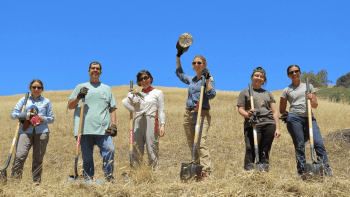
“It’s a beautiful example of people coming together, working toward a shared vision, and connecting.”
